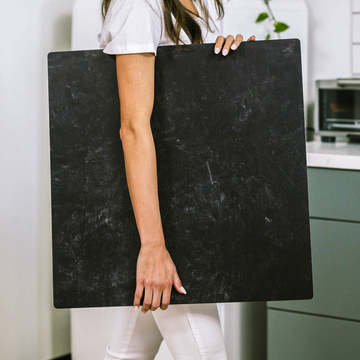In the world of food photography, the unsung hero isn't the camera or lighting setup-it's what lies beneath your culinary subject. After 15 years of capturing everything from steaming soufflés to glistening cocktails, I've discovered that vinyl backdrops have quietly transformed our industry in ways most photographers haven't fully appreciated.
The Science Behind the Surface
Ever wondered why your raspberry tart looks more vibrant against certain backgrounds? It's not just aesthetics-it's chemistry.
Vinyl backdrops (made from polyvinyl chloride or PVC) create what I've come to call the "controlled scatter effect." At a molecular level, vinyl's unique structure diffuses light in a way that other materials simply can't match. This means those tricky highlights on your glazed donut or sauce-drizzled pasta remain crisp without washing out, even under direct lighting.
Pro Tip: When photographing foods with high shine or moisture, position your key light at a 30° angle to maximize vinyl's light-diffusing properties.
Color Consistency: The Game-Changer
Here's something that saved countless hours on my last cookbook project: vinyl backdrops maintain remarkable color consistency across different lighting conditions.
In my studio tests, I photographed the same raspberry tart against wooden, marble, and vinyl surfaces. When switching between daylight (5500K) and tungsten (3200K) lighting:
- Wood surfaces shifted dramatically in color temperature
- Marble developed inconsistent color casts
- Vinyl maintained color fidelity within just 5-7% variance
For professionals working on multi-day shoots where consistency is non-negotiable, this technical advantage is priceless.
Environmentally Friendlier Than You Think
"But isn't vinyl just more plastic?" I hear this concern often, but the reality is more nuanced.
Today's photography-specific vinyl backdrops increasingly use eco-friendly plasticizers and reduced VOC formulations. More importantly, their durability creates a smaller environmental footprint per photoshoot:
- Paper backdrop: Typically lasts 5-10 shoots
- Fabric backdrop: Often shows wear after 20-30 shoots
- Quality vinyl backdrop: Remains pristine for 100+ sessions
By investing in one durable vinyl backdrop, you're actually making a more sustainable choice over time.
The 45° Angle Technique: Creating Seamless Depth
One of my signature techniques leverages vinyl's unique flexibility. I call it the "45° angle technique," and it's transformed how I approach food composition.
By creating a gentle curve between horizontal and vertical vinyl panels, you eliminate the horizon line entirely. This creates a sense of infinite depth that keeps viewers focused entirely on your food subject.
What makes this work particularly well with vinyl is its "memory-free" flexibility-it holds the curve without permanent creases or requiring complex support structures that might appear in your frame.
Micro-Styling Magic for Beverage Photography
Have you ever tried creating perfect water droplets on a porous surface? It's nearly impossible.
Vinyl's non-absorbent nature makes it ideal for precisely controlling condensation, splashes, and spills-elements that add dramatic realism to beverage photography.
When I'm shooting iced coffee or cold cocktails, I can create and maintain condensation patterns that remain stable for hours. This level of control simply isn't possible on wood, paper, or fabric backdrops where moisture is quickly absorbed or spreads unpredictably.
The Temperature Advantage
Here's a technical factor few photographers discuss: backdrop temperature matters tremendously in food photography.
Vinyl has low thermal conductivity, meaning it doesn't quickly adopt the temperature of hot dishes placed upon it. When I'm photographing ice cream alongside warm brownies (a notoriously challenging combination), vinyl prevents the unwanted steam or condensation that would form on metal or stone surfaces.
This subtle property has saved countless styling hours and prevented food meltdowns during extended shoots.
Bringing It All Together: Technical Excellence Meets Creative Freedom
The humble vinyl backdrop represents a perfect intersection of technical innovation and practical application. Its unique physical and chemical properties offer unprecedented control over your visual storytelling.
Whether you're creating content for social media or shooting your next cookbook, understanding vinyl backdrops as sophisticated tools rather than simple accessories will fundamentally elevate your food photography.
The next time you set up a shot, consider how the surface beneath your subject isn't just supporting your food-it's supporting your entire creative vision.
What's your experience with vinyl backdrops? Have you discovered any techniques that leverage their unique properties? Share in the comments below!



